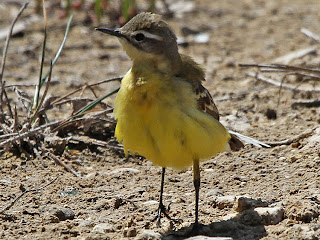One enjoyable moment hunting for migrants in Sicily was finding a mixed flock of 10 flava Wagtails in a dried out pool at Capo Murro di Porco. It contained Blue-headed Wagtails, Grey-headed Wagtails, a Black-headed Wagtail (nice call) and another curious bird, the point of this post.
Before I get on to the bird in question, let me wallow in some Grey-headed loveliness:
Grey-headed Wagtail, Capo Murro di Porco, 4th May 2012
I didn't manage to get such a good shot of the Black-headed, but it was such a gorgeous bird I can't resist sharing it:
Black-headed Wagtail, Capo Murro di Porco, 4th May 2012
And now, the bird I'm really writing about. This was a really striking bird! A lovely dark slaty-grey head, really dark at the front (fore-crown, lores and front of ear-coverts) but paler, almost bluey grey at the rear. A vivid white supercilium and white lower eye-crescent, but no white in the middle of the ear-coverts. The throat was clearly yellow but the chin was white, with white extending slightly down the moustaches. Here it is:
flava Wagtail, Capo Murro di Porco, 4th May
So what is it? Yellow throat should rule out the cinereocapilla/iberiae complex I thought it might be a Romanian 'dombrowski'-type intergrade? What do you think?























